 |
 |
 |
||||||||||||||||||||||||||||||
The Bible and the Ten CommandmentsThe Law of God - Part TwoThe Bible and the Ten Commandments form the basis for our understanding of the Law of God. From the characteristics of God and the great spiritual needs of man, studied in Part One of this study, we can list eight principles:
In Part One, we have already discussed somewhat how God has meet man's needs of motivation, man's need of a standard and his need of reminders. From that point we will go on in the Bible and the Ten Commandments to understand more of God's law and how it meets man's needs. Here is the diagram we finished with in Part One having just added "Sin in Eden" to our bottom time line. The diagram shows the relation of the principles we have covered to this point to the major events of salvation history.
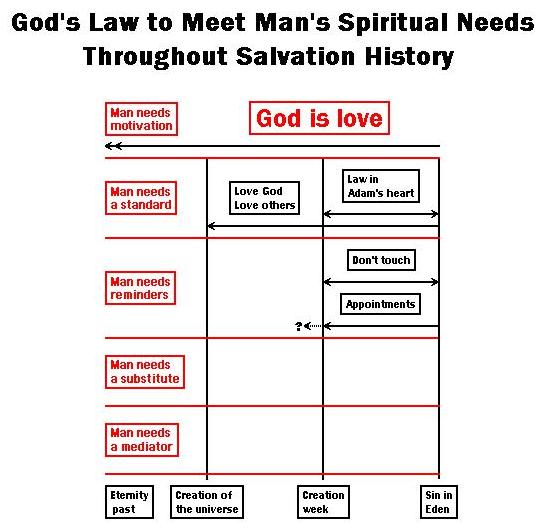 Ten Commandments in Existence Before Sinai When man sinned he broke the law. But he did not break it like breaking a glass or mirror; he broke it by not meeting its requirements. The law did not change, what changed was the behaviour of man in relation to that law - he did not meet its requirements. But since the law was now no longer in his heart, he needed an external source of information as to what was right and wrong. God's law was expanded or amplified as needed to meet the circumstances of His created beings. God will always have a moral law, a standard of conduct. Fallen man needs to understand, by seeing himself in relation to that law, that he is a sinner to help him to sense his other needs. We could say that the Ten Commandments are ten principles based on the principles of love to God and love to others. It is important to understand that these existed before the Ten Commandments were given in stone at Mt. Sinai. A familiar example is God's promise to provide manna in the wilderness each day except the Sabbath:
Others include references to the commandments to not steal or lie or covet:
Before Mt. Sinai, God made a promise:
Notice that along with the commandments, in the same promise, He mentions His statutes. Close investigation shows that the statutes and judgments also existed before Mt. Sinai.
Malachi indicates that the commandments statutes and judgments all go together as a package:
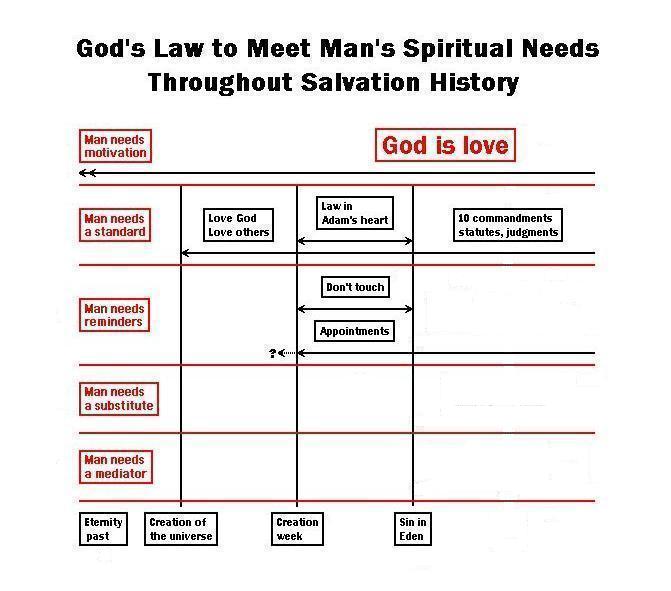 Note that the Ten Commandments and their associated statutes and judgments are not shown as starting at the point of "Sin in Eden" but are, rather, a continuation of God's law from the beginning. God's law has always existed and been based upon the principle that God is love. The diagram above shows that at the point of sin entering it was further expanded. The diagram below illustrates how it was expanded further to meet the needs to man.
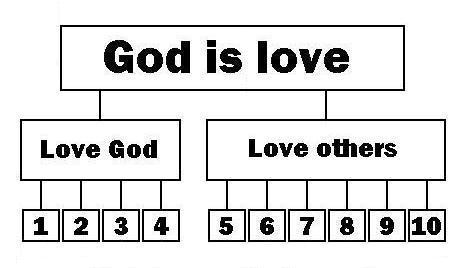 Man Needs a Substitute Man's first new need once he sinned - to be able to continue living when he deserved the second death - was immediately supplied by God in the promise of a Saviour. As soon as there was sin there was a Saviour. Man needs a substitute, someone to stand in his place and pay the penalty of his sins for him because he cannot pay on his own behalf. Actually, he can but the price is eternal death and this cuts him off from relationship with God and eternally ends his very existence. Only by having a substitute pay the penalty for him could man be cleared (justified) and not be eternally separated form God. We commonly think of animal sacrifices as substitutes but they only pointed forward to Jesus who was our sacrifice and substitute. Animal sacrifices will be covered more below under the category of reminders.
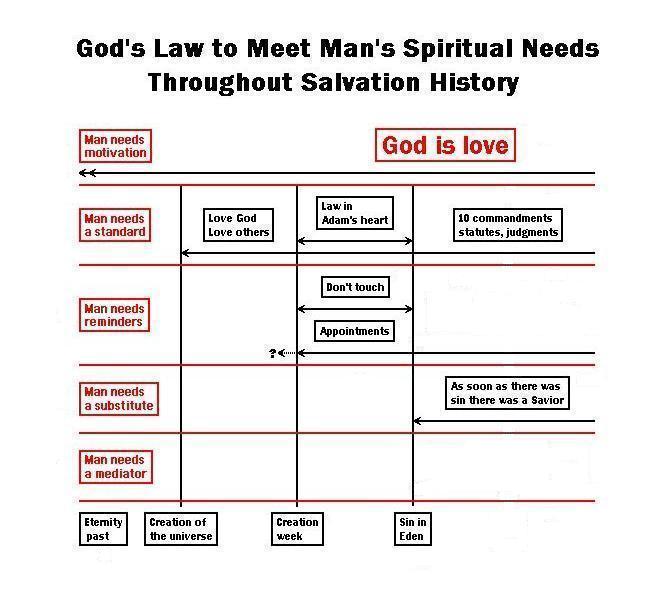 Man Needs a Mediator Man's other new need also came immediately when sin occurred because his sin caused a separation between him and God. They could no longer have face-to-face communication.
No man has seen God the Father. It is and has been since the fall, the role of the Son to make the Father known or to "declare him." To show what He is really like; especially in character.
Without some kind of protecting veil between, the glory of God is too much for man in His sinful state to bear.
As soon as mankind sinned, a solution was provided. Because man was separated from God, he needed some kind of connection, a mediator, because to be separated from God who is life, means death.
It is only because man has a Saviour and has had from the moment of his first sin that he can continue to live. This Saviour would, of course, fill the role of substitute already mentioned but would also, by this and other aspects of the role of Saviour, bring about a reunion between God and man thus dealing with man's third spiritual need. Jesus was appointed for this role long before His birth as our Savior:
Jesus, when He appeared to man to communicate with Him, came with His divinity veiled. He had the form of a man when He appeared to Abraham.
Of course, during His incarnation on earth, Jesus was in the form of humanity. So there is only one who can really function as mediator between God and man but there is a sense in which others have served as mediators. Not much is said about the priesthood before Sinai, but we know that "Melchizedek ... was the priest of the most high God." (Gen 14:18). The patriarchs served as priests for their own families. We will include the earthly priesthood in our diagram recognizing that they (the priests themselves) also need a mediator and only Jesus can really fulfill that role. Jesus is the only one who can truly be our mediator, or go-between, because of His unique position:
Any one else who we might think of as a mediator is not, in the true sense of the word. However, God has designated different people (priests) to symbolically function in this role. They have helped point people to their need of reconciliation with God but they do not accomplish it. Their primary function is to point us to the true mediator and high priest - Jesus.
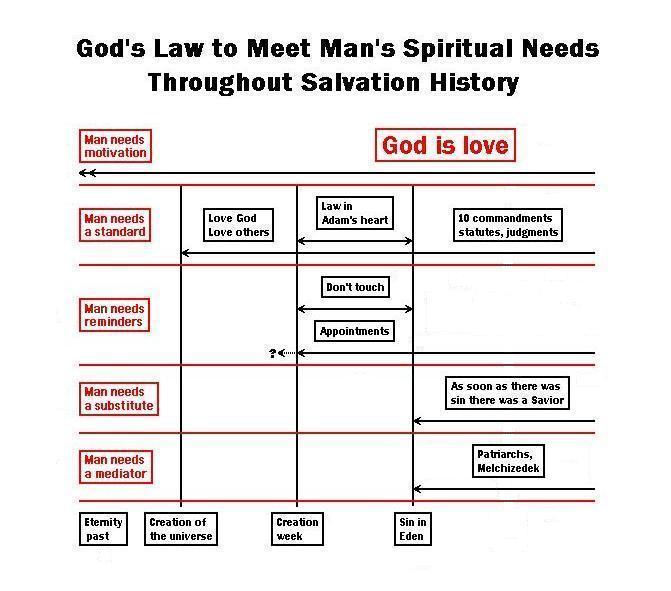 Man Needs Reminders The offerings simply pointed to the Saviour. They composed what is often called the ceremonial law. God does not have His people perform ceremonial rites simply for the sake of ceremony, to give them something to do. There has to be a meaning, a purpose behind it. In this case, it is to point them to or remind them of the Saviour to come. Once the reality has come that the ceremony points forward to, the ceremony is, obviously, no longer needed. We just have to sort out and distinguish what is reminder and what among the Jewish economy served other purposes. We will see that man's need of reminders will extend beyond the end of sin. In fact, as we have seen, they existed before sin. Reminders such as the sacrificial system are needed not to provide salvation, which does not come from the sacrifice of animals, but because we are so prone to forget. The reminders help not just to remind but to encourage us. The Bible is loaded with what we call promises and Bible readers are very aware of these and greatly cherish them. We understand that man is never saved or even forgiven just because he offers a sacrifice. But through the faith demonstrated - faith in a promised Saviour to come and what that Saviour would accomplish - man could be cleared of His guilt and the record against him.
The first animal sacrifice happened right in Eden:
In Genesis 4, Cain and Abel brought offerings. They were instructed in this long before Mt. Sinai. Abraham and many others offered sacrifices. Sacrificial offerings pointed forward to the death of Christ as the great sin offering assuring man that a substitute had been supplied and that God would take care of the problem. Sacrifices are not part of the moral law. In the absence of sin there would be nothing morally correct about sacrificing a lamb rather, the opposite would be true. They were added as a consequence of the breaking of the moral law, as part of the solution. Sacrifices belong in the area of reminders because they were not the substitute itself but only pointed to it.
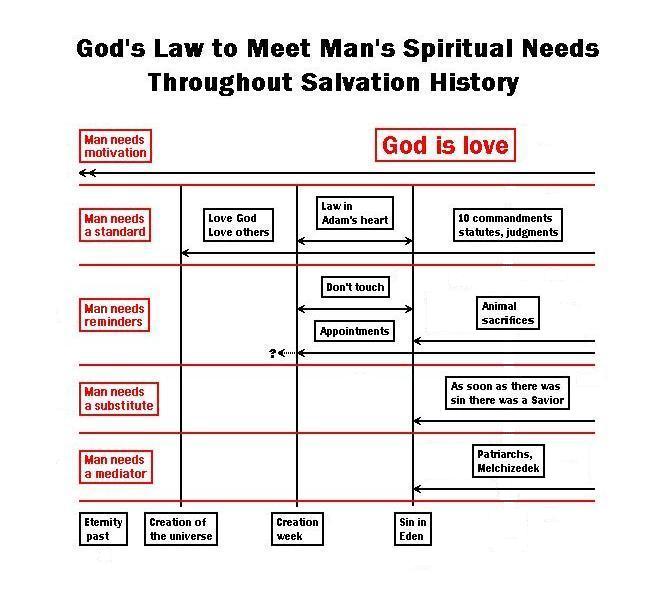 The Ten Commandments One of the most significant points in history in understanding God's law is the formal giving of the Ten Commandments written in stone and the associated events that occurred at Mt. Sinai. There has been much misunderstanding with many people thinking that the Ten Commandments (moral law) and other laws were first given at Mt Sinai. Sinai did correspond to a spelling out in much more detail of the sacrificial and priestly systems for the people. However, as we have already seen, there already were sacrifices and priests prior to this. We can see that the principles of God's law were already in place long before and that Mt. Sinai was the point of amplification of both the moral and what has been called the ceremonial law. To some degree, the laws "given" at Mt. Sinai were to meet the needs of the Nation of Israel which was being formed at that time. To help understand what was really given at Mt. Sinai, let's establish what already existed:
Standard, substitute, mediator and reminders all existed.
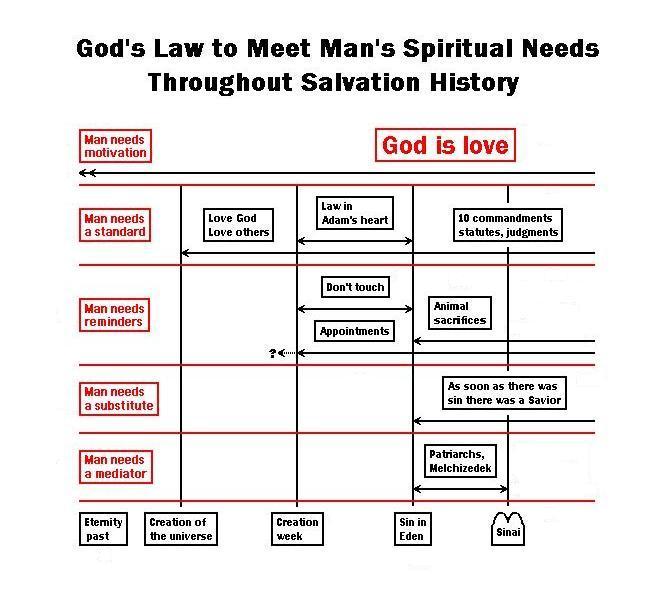 The diagram above shows the law (Ten Commandments, statutes and judgments) and man's need of a substitute (as soon as there was sin there was a Saviour) continuing past Sinai. The Ten Commandments were given in a more formal manner and were the basis of a covenant concerning them. It is important to understand that the Old Covenant was not the Ten Commandments themselves but an agreement concerning the keeping of them. Additional statutes and judgments were given also. Of course, man's need of a Saviour continues. We will see that in the area of animal sacrifices and the priesthood there were some changes. Old Covenant Made A key to understanding Sinai is to understand the distinction between the old and the new covenants. We will briefly review that topic and the order of events here to help make the diagram clear. At Sinai, the covenant was first proposed by God in general terms:
It is important to note that God was not proposing an Old Covenant. He is only interested in the everlasting covenant. The people replied
They had thus, at this point, committed themselves to doing God's will; they had agreed to enter into a covenant with God. What made this the old covenant was that the people were actually dictating how it was to be carried out. They quickly responded even before knowing everything that God would require on their part. After the Lord had made a covenant with Israel they were brought forth to meet with Him.
When the Lord spoke his law in what we know as the Ten Commandments in Exodus chapter 20 it was not to give a new law, but to speak with an audible voice in the hearing of all the people, his law which already existed. Statutes and judgments, including feasts, given In Deuteronomy 5, Moses recounts to the people the events of Sinai. He mentions how "The Lord talked with you face to face in the mount" (v4) and gave the Ten Commandments (v7-21). He tells of the people's reaction and desire to not have God speak directly to them but rather to speak through Moses (v24-27, Deut 5:4-5). God then agreed to their request and said to Moses "I will speak unto thee all the commandments, and the statutes, and the judgments, which thou shalt teach them, that they may do them." (v31). It was then that through Moses they were given a number of religious precepts which were to govern the everyday life. These statutes were not the Ten Commandments over again, but the finer points of the law.
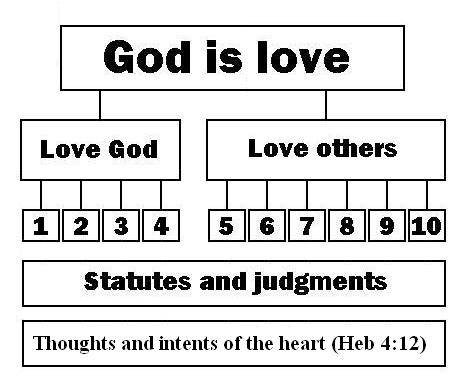 Book of the law written All of these statutes and judgments were recorded for the benefit of the Israelites. It wasn't merely God exercising His sovereignty; all were given for the good of Israel. We are told where they were placed:
It is often assumed that because they were not inside the ark they were therefore temporary in nature. This is, of course, only an assumption and we are told in the rest of the verse why they were placed there:
The reason given is to be a witness. How could it be any more of a witness "in the side of the ark" than if it was actually inside the ark? One obvious possibility is that it was placed there for more ready access than if it was on the inside which would necessitate lifting the lid to retrieve it. Covenant ratified
Then "Moses wrote all the words of the Lord" (v4). Then he took this "book of the covenant, and read in the audience of the people" (v7) and they again affirmed their agreement to keep them saying "... All that the LORD hath said will we do, and be obedient." (v7). The covenant was then ratified in the normal manner, with blood which was "... sprinkled ... on the people ..." (v8) and the Lord told Moses "... I will give thee tables of stone ..." (v12) The argument is used concerning the seventh-day Sabbath that nothing could be added to or removed from the new covenant after Christ's death (its ratification) and that Sunday-keeping thus came too late. By the same reasoning, the sacrifices described as being given after the ratification of the old covenant could not be a part of the moral law and thus must be distinct from it. That doesn't mean they were not to be observed right after Sinai, just that they were not part of the moral law. Only after the agreement (covenant) between the people and God concerning the moral law was made and ratified did He even begin to give them instructions for the construction of the tabernacle and for the establishment of the priesthood. (Exodus chapters 25-31). The only regular sacrifice (other than those involved in consecration) that is mentioned at this point is the continual burnt offering. (Exo 29:38-42) Ten commandments written in stone At this point, after giving the instructions for the construction of the tabernacle, God gave the tables of stone (the first set) as a record of his law:
The Ten Commandments themselves were not new. However, they were expanded upon; given in more detail in the form of statutes and judgments. These were merely the principles of the Ten Commandments amplified in more detail and applied to everyday life. Note that the "ten commandments, statutes and judgments" starting at Sin, continue right past Sinai and into the future. They are an amplification of God's law, not a change. Tabernacle built Only after the covenant had been made and the law had been written in stone was work begun on the tabernacle. This is described in Exodus chapters 35-40. The book of Exodus ends with the completion of the tabernacle:
It was only after the construction of the tabernacle was completed that:
Instructions Given for Sacrifices After the completion of the tabernacle, God communicated with Moses from the cloud above the mercy seat to give him full directions concerning the system of offerings and the forms of worship, the ceremonial system, to be maintained in the sanctuary. These instructions for the various offerings were given in Leviticus chapters 1-8.
Let's review the order of events and again see the distinction between moral and ceremonial law:
Also, the instructions were given for the outfitting and the responsibilities of the priests. Again, as when we discussed the priesthood of Melchizedek earlier, any one filling the role of a priest has the function of pointing us to the true mediator and high priest - Jesus.
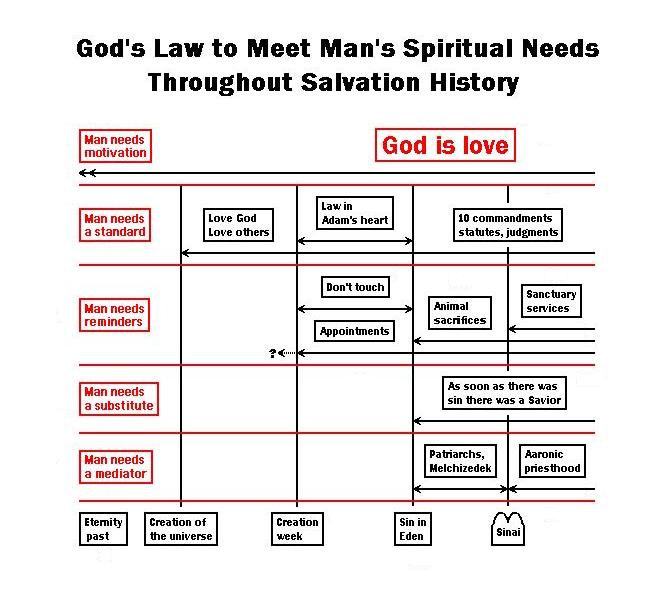 End of Part Two
|
Prophecy Newsletter
Receive
free newsletters
reporting and analysing world events related to prophecy.
The Greek has multiple words for forgiveness? God forgives (charizomai) whether we ask or not. Receiving forgiveness (apheimi) is by our choice.
God always forgives!
|
|||||||||||||||||||||||||||||||
|
|
||||||||||||||||||||||||||||||||
|
| ||||||||||||||||||||||||||||||||
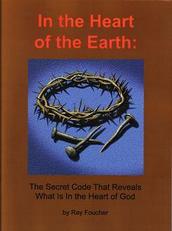
New! Comments
Have your say about what you just read! Please leave a comment below.